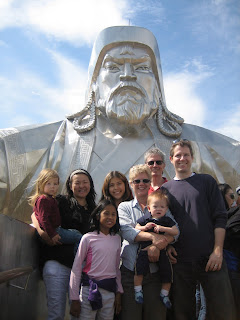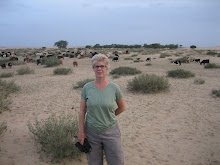Most people, when they hear about our round-the-world trip, respond something like this:
"Oh, I would love to do that, but we could never afford it." Here, then, are our figures, so you can see if that's really true. I believe if you really want something, you will find a way to do it.
We had a pretty cushy trip, really. We always slept in comfortable places, we ate well (and saved a bundle by preparing most of our own food) and we splurged on a few activities, such as tickets to
Lion King in London and Disneyland in Tokyo. We spent most of our time in Europe, a very expensive part of the world. But we offset that with free lodging through home exchanges, which was our biggest money-saver. There are lots of ways to lower your travel costs. Prices vary dramatically around the world, so either go somewhere cheap or set up home exchanges. We used
www.homelink.org, but there are a number of reputable home swapping organizations.
We were lucky in that Stephen could work along the way, so we had some income throughout the trip. Many jobs can accommodate telecommuting. It puts extra stress on the wage earner, and therefore on the family, so weigh the costs of such a plan. The insurance benefits and income were worth it for us, though frankly, it would have been a better trip if none of us had to worry about finding internet access and fitting in work hours each week. It did allow us to return home in pretty good financial shape, though, so I'm grateful.
Another key thing is to lower your costs at home as much as you can. We set our mortgage payment to pay only interest for the interim of the trip. We cancelled all magazines and lessons and services we wouldn't need. We set our Comcast account, utilities, hot water heater, and car insurance on "vacation" mode until our home exchangers arrived. We kept our charitable giving and college savings plans in place, but you might adjust yours. We used automatic payment plans to pay all bills. Online banking makes it easy to take care of financial business from anywhere in the world. If you still have car payments or other credit accounts, pay those off before you embark on a big trip like this. And it's essential to have someone you trust at home to take care of any unexpected bills or problems. (Thanks, Genevieve and Scott!)
Here, then, are our costs for our trip. Remember ,this is for four people, three adults and a child.
(There's another cost-saving tip: take your children before they are twelve and have to pay full price for most things, including airfares.)
Flights and long-distance buses and trains: $11,000Portland-Chicago-Guatemala City-Atlanta-Malaga-Barcelona-Ibiza-Barcelona-Marrakesh-Pisa-(train)-Venice-Paris-Copenhagen-(bus)-Hamburg-(bus)-Antwerp-(train)-London-Dublin-London-Beijing-Ulaan Bataar-Tokyo-Portland
Car rentals, gas, and local transportation: $2,500Car rentals and gas are expensive in Europe, but often the best way for a group to travel. We rented cars in Malaga, Barcelona (for moving around Spain), Ireland, and we hired a van with driver in Mongolia. In cities, we used local subways and bus systems.
Food: $3,300Includes groceries, dining out (mostly in cheaper places like Guatemala and China) and gelato every day in Italy.
Lodging: $4,800Motels are very expensive in Europe, much more reasonable in some other places. We spent $1,300 for an entire month's lodging in Guatemala and $1,050 for just six days in Ireland. In Mongolia, we spent $150 on six days at tourist camps. We used three weeks of timeshare exchanges in Spain, and rented apartments whenever possible, which saved a lot on food costs. And in Chicago, Atlanta, Ulaan Bataar, and Tokyo, we stayed with family, always a welcome option.
Activities: $3,000Includes Spanish classes, museums, local tours, shows and concerts, amusement parks, etc.
Total: $24, 600 for 5 1/2 months of (cushy) travel for a family of four

 From the charming rusticity of Mongolia, we came to super-efficient Japan. Our son, Gordon, and his girlfriend, Aya, live in Tokyo. This is the view from their lovely apartment on the 45th floor of Harumi View Towers.
From the charming rusticity of Mongolia, we came to super-efficient Japan. Our son, Gordon, and his girlfriend, Aya, live in Tokyo. This is the view from their lovely apartment on the 45th floor of Harumi View Towers. Tokyo is a modern, busy city, but it does have areas that evoke the feeling of old Japan.
Tokyo is a modern, busy city, but it does have areas that evoke the feeling of old Japan. Gordon and Aya pose in front of a Buddhist temple in Akasuka. We had such fun being with them. Aya is a marvelous cook and we enjoyed many a fine meal at their table.
Gordon and Aya pose in front of a Buddhist temple in Akasuka. We had such fun being with them. Aya is a marvelous cook and we enjoyed many a fine meal at their table.
 Grace and Zach ride a yak.
Grace and Zach ride a yak. Gloria in front of our ger at a tourist camp.
Gloria in front of our ger at a tourist camp. Inside a local family ger, having breakfast of sweet rice and milk.
Inside a local family ger, having breakfast of sweet rice and milk. Stephen reads inside our ger.
Stephen reads inside our ger. The source of your cashmere.
The source of your cashmere. We had a great evening playing in the dunes of the Little Gobi desert.
We had a great evening playing in the dunes of the Little Gobi desert. The countryside is very fine.
The countryside is very fine.










